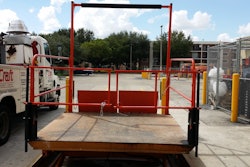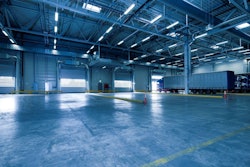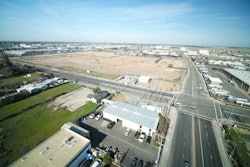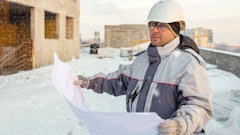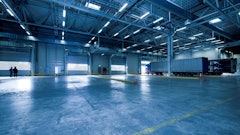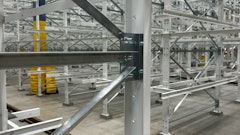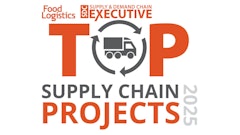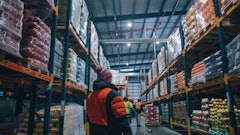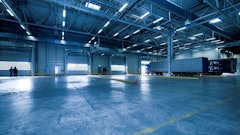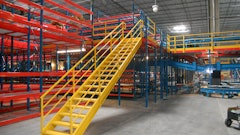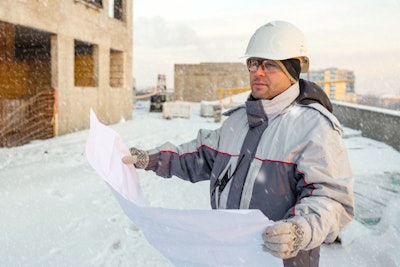
It’s no secret – the country’s supply chain is suffering from gridlock as the entire world tries to slowly emerge from the effects of the pandemic. You can see it offshore where container ships are anchored for miles, waiting to be offloaded at U.S. ports. You can see it on the docks where trucks and drivers are in short supply. The closer you get to the destinations, you also find a shortage of warehouse space, especially for highly perishable items requiring cold storage.
The problem is especially complicated when Mother Nature hammers the economic lifeline of communities with the likes of tornadoes, hurricanes, earthquakes, wildfires, flooding and other unforeseen disasters. The ripple effect is that any delays in product shipments to restaurants, grocery stores and other retail food outlets cause shelves to go bare, prices to increase and shoppers’ frustrations to grow.
While we can’t stop Mother Nature, the supply chain industry can control warehouse and cold storage environments to keep damage to a minimum or eliminate it altogether.
The demand for high-quality cold storage facilities, due to the need for speedy deliveries, is at an all-time high. Customers are asking how fast their warehouse freezers can be completed before they ask about cost, despite the fact that cold storage is the most expensive supply chain component due to the fragility of the product being moved, as well as the higher costs associated with refrigeration and keeping foods frozen until needed.
These companies depend upon accurate and safe delivery of temperature-sensitive, highly perishable items every day to keep their businesses open. As a result, they need the right solution to be implemented along with the expertise when selecting how a cold environment is to be installed.
While planning for a new or retrofitted cold storage warehouse facility, there are several vital factors to be considered:
Size and space availability. In today’s scramble to accommodate the growth, most facilities are struggling to retrofit existing freezer units to maximize whatever square footage they have. At the same time, companies sourcing additional real estate and builders are pushing hard to meet the demand.
For instance, whenever restaurants add a new menu item, it results in a whole new skew and a new pallet that must find space in the cold storage warehouse. This creates another challenge to warehouse operators.
Racking. Structural steel racks are superior due to their high levels of flexibility, endurance and temperature adaptation to any pallet load, whether frozen foods, meat processing, produce, seafood or beverages. When designing a cold storage facility, ask, “will that rack configuration hold up over time whether it is in a 30°, 0° or -15° (ice cream) environment? Also, if the facility is in an earthquake-prone region, can the racks withstand seismic activity?”
Cold storage environments are also harder to upkeep than dry storage. Because of the low temperatures associated with refrigeration and freezers, the rack structure is vulnerable to both corrosion and equipment deterioration and to any damage caused when hit by warehouse forklifts and other mobile devices. From a cost-saving perspective, it’s always a good idea to utilize racking that allows for sectional piece replacement instead of being forced into rebuilding the entire structure.
Because cold storage square footage is so expensive, cold storage pallet rack must be compact, while still allowing ample storage. Storage density is critical since cold goods also help to keep nearby goods cold, reducing overall energy costs and conserving cold storage space for more items.
Automated storage solutions such as pallet flow help ensure inventory rotation, reducing or eliminating the possibility of spoilage by enforcing first-in, first-out (FIFO) picking. For the same reasons, drive-in and drive-through racks also are excellent choices for cold storage pallet rack, and these racks can handle high volume. Both rack types help maintain temperatures in cold storage by enabling dense storage of products and minimizing aisles and open spaces that allow cold to escape.
Click here to hear more about new ways of warehousing today:
Infrastructure. The actual construction of the cold storage facility is crucial to maintaining its contents. For instance, the walls must be built with certain kinds of insulation for temperature control, while blowers and fans must meet the exact specifications required to maximize uninterruptible operations. An ice cream room is the coldest and will be the most expensive to build and maintain with potentially millions of dollars’ worth of perishable food. If not kept at constant temperatures, or if the contents somehow get damaged in movement or collapsing racks, valuable commodities will literally end up in dumpsters.
Fire protection. Although we are talking about “cold” storage, the reality is that the chances of fire in these types of facilities is often greater than in a normal warehouse situation. According to the National Fire Protection Association (NFPA), most products stored in cold storage are combustible along with the construction and delivery materials. Meal kits, groceries and pharmaceuticals are delivered in cardboard boxes or on polystyrene trays often stored on larger cardboard pallets in the storage space. All of these make up the perfect fuels to complete the fire triangle of oxygen, heat and fuel.
In addition, other potential fire risks include high-intensity discharge (HID) lighting, common in modern warehouses, where the temperature inside the light bulb can reach about 1,000 degrees. An NFPA study found that 18% of warehouse fires from 2009-13 were attributed to electrical distribution and lighting equipment. Ammonia-based refrigeration equipment also presents fire concerns, and at concentration levels of 15-18%, ammonia can serve as an accelerator for a fire breakout. The study also revealed that among the leading causes of fire in cold storage facilities are forklifts, hot environments and arson.
If that isn’t enough, another significant concern is the sprinkler fire suppression systems in box-in-a-box applications. When the conditioned space is penetrated by every sprinkler, it is critical to isolate the potential for differential movement between the shell structure and the insulated structure. Whether it is due to refrigeration system vibrations over time, stress on the insulated structure due to service foot traffic or a roof sagging from snow loading, fire protection systems are at risk of having the foam or glue break around penetrations, causing unwanted condensation and ice buildup.
The good news resulting from today’s soaring demands for cold storage facilities in general, and improved fire protection in particular, is the increase in technological advances. They include higher-ceiling-only sprinklers, “smart” sprinklers, dry and pre-action sprinkler systems filled with nitrogen, large X-factor dry sprinklers with flexible connections for box-in-box and oxygen reduction.
Understanding the many components, regulations and considerations that go into designing, building and maintaining cold storage facilities is key to selecting a vendor for new or existing facility installation.

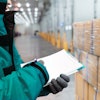
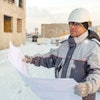
![Adobe Stock 280800711 [converted]](https://img.foodlogistics.com/files/base/acbm/fl/image/2021/08/AdobeStock_280800711__Converted_.611e898daa123.png?auto=format%2Ccompress&fit=crop&h=167&q=70&rect=0%2C53%2C900%2C507&w=250)
